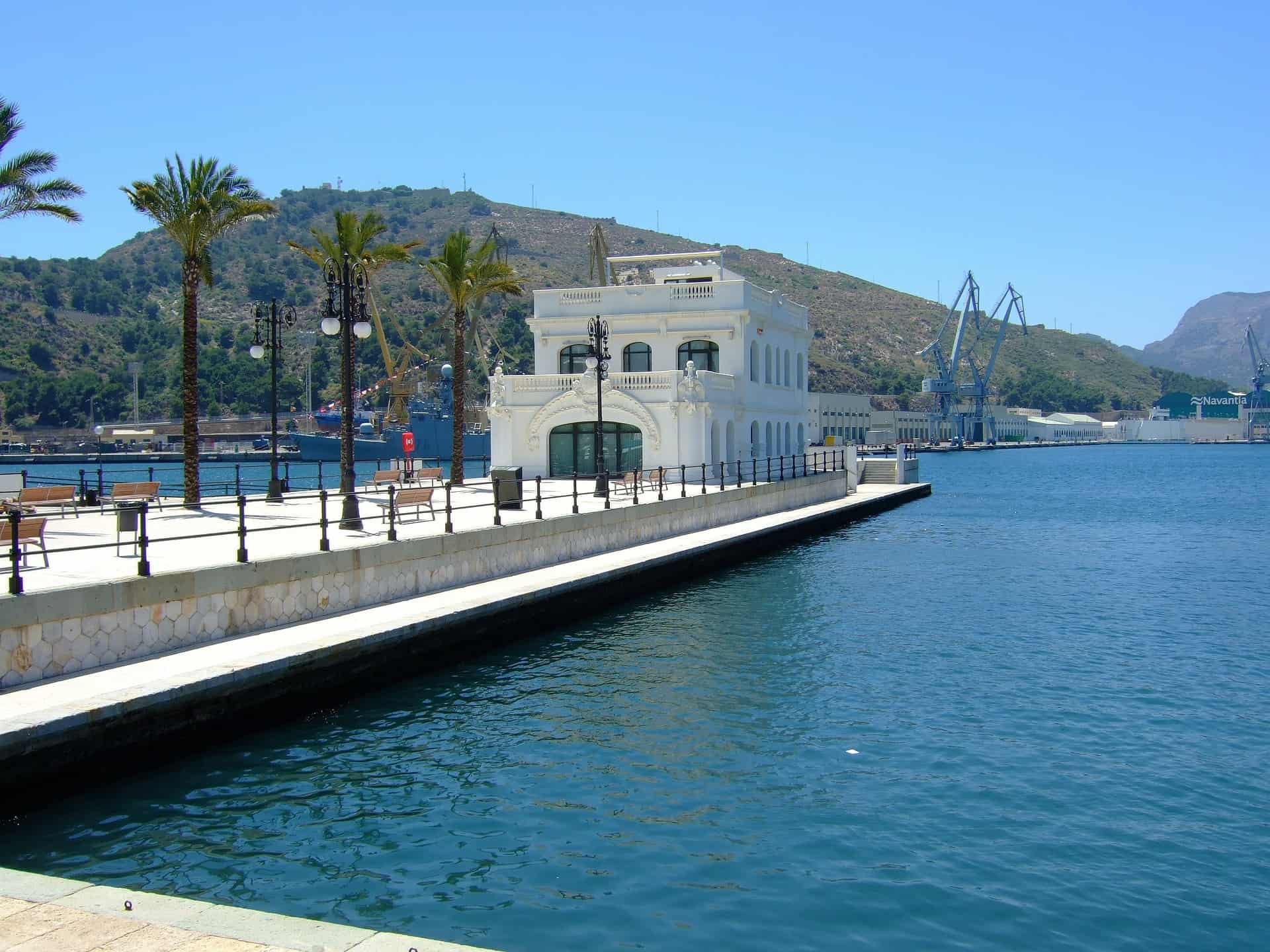Top Things To Do In Cartagena

Updated On: November 07, 2023 by Esraa Mahmoud
Founded in 227 BC by the Carthaginian Hasdrubal, Cartagena is a lively port city on Spain’s southeastern Mediterranean coast. The city has a long history with a wealth of monuments documenting the influence of many cultures.
Cartagena’s geographical location and proximity to the sea marked its primary functions, trade, and protection of the territory. Various ships are still moored to the city’s shores, and structures from the heyday of the Roman Empire have been preserved in the center of Cartagena. Even today, the architecture of the Spanish city is distinctly medieval, but there is something to see for enthusiasts of the later eras like baroque and art nouveau.
As a rather small city, it is easy to go from one place to another in Cartagena. You can start with the remains of the Punic walls, then continue to the second-largest Roman theater of the Iberian Peninsula and finish the day with a panoramic view of the city and the port aboard a harbor cruise. In addition, lovers of maritime will be delighted by the Naval Museum and a model of the first submarine in the world, invented by Cartagena native Isaac Peral and launched in 1888.
Helping you have the best trip in the city, here is our list of the best things to do and the best places to visit in Cartagena.
Tour of the Roman Theater
Of all the wonderful Roman monuments in Cartagena, the 2,000year-old theater should be your first port of call. It was recently discovered in 1988 under the ruins of the old cathedral, which had been destroyed during the bombing of the Spanish Civil War.
Cartagena has the second-largest Roman theater in the Iberian Peninsula. Dating back to the first century, it was opened in honor of the visit of Gaius Cesar, grandson of Emperor Augustus. Behind and visible from the top-tier theater are the Cathedral of Cartagena and the remains of a Byzantine wall.
About two-thirds of the building materials of the theater were still in place when it was discovered. The theater could accommodate more than 6,000 people. It is accessed via a pink building, which also houses the Roman Theater Museum.
Over three floors, the museum has a huge collection of Roman statues and artifacts, then leads across a glass bridge into the theater itself. In the museum, you will see the fantastic objects discovered during the excavations, among which is an altar to Jupiter, a statue of Apollo, engraved lintels, plates, and Islamic ceramics of the Middle Ages. Visiting the Roman Theater and its museum is the perfect start for your activities in Cartagena.
Understanding Ancient History at the Punic Wall
Cartagena has made great efforts to explain its sometimes-complicated history for visitors. This is clear in the Punic Wall Interpretation Center, which protects the remains of Cartagena oldest part, the Punic Wall, under glass walkways, while a video explains the foundation of Cartagena.
It is of particular historical value because there remain very few Punic Spain. During excavations, the 16th-century hermitage of San Jose was discovered. What remains is the crypt of the monk, with bones and skulls resting in several stories of burial niches and a rather macabre representation of the dance of death. The Punic Wall in Cartagena is not like anything you have seen before.
Marvel at the Casa de la Fortuna
You have seen the theater and the history of the port; now is your chance to know how the rich citizens of Roman Cartagena lived. Cartagena lived through its prime when it was part of the Roman Empire.
The wealth of its citizens derived from trade and abundant silver mines in the surrounding countryside. The Casa de la Fortuna is proof of that. This is a marvelous and well-preserved Roman villa from the first century.
The name of the building comes from a Latin inscription on its back entrance: “Fortuna Propecia,” which means “good luck” and would have greeted all visitors. It is easy to become familiar with the site, so many walls and decorations remain as well as a part of the Roman road outside.
Furniture, tools, and mannequins dressed in period clothing evoke a vivid image of how a wealthy Roman merchant lived. Discovered only in 2000, the villa originally expanded to 2,200 square meters. At the back of the house, you can see part of a Roman road with huge stone slabs and remains of their advanced channeling.
Make sure to visit Casa de la Fortuna and admire the floor mosaics and colorful murals, including a swan, which is the most famous image of the villa.
Discover Art Deco along with the Calle Mayor
Connecting the Plaza de San Sebastián to the north to the Cartagena City Hall, this ravine-like pedestrian street, Calle Mayor, is paved with distinctive blue marble slabs. It is a typical Spanish “Paseo,” where families and couples walk together or meet with friends.
At the beginning of the 20th century, the growing mining industry brought prosperity to the city with its richly decorated houses and public buildings. There are many outstanding examples of that, like the triangular city hall and the casino. FYI: casinos in Spain are not for gambling, but they are the seat of a cultural society.
The street homes many remarkable buildings like the former Grand Hotel, now a bank, and the pink and white Casa Aguirre, which also houses the Museum of Regional Modern Art. Finally, make sure to take a break in Cartagena’s most traditional bar La Tartana.
Batería de Castillitos
Sitting 30 minutes from Cartagena is the spectacular Cape Tiñoso, which is accessible by dirt roads. At its tip of 250 meters, you can admire the extraordinary mountainous landscape of this natural park.
After spending some time at the top, go visit the installation in the area that mixes frivolous architecture with fleshy and sinister artillery guns. It was built in the mid-1930s during the reign of Primo de Rivera as part of a series of batteries defending the coast of Cartagena.
The Batería de Castillitos is an amazing historical site that you must include in your itinerary while in Cartagena.
Castillo de la Concepción
Cartagena had long been in decline by the time the Moors arrived in Spain. And for centuries, it was believed that they had not left any mark on the city at all, but excavations of the walls of this Castillo de la Concepción proved otherwise.
Located on the hill of the same name, the castle was an Alcazaba, a fortified palace from the Middle Ages. Long before that, it was a Roman temple of Aesculapius, and the cisterns from that time are still intact.
After marveling at the outside of the castle, take the elevator to the top for supreme views of the harbor and coastal mountains.
Riding the Waves on a Harbor Tour
The natural, protected port of Cartagena is the main reason why so many cultures fought over it. To truly appreciate the beauty of the city, we recommend taking a harbor tour to enjoy the best view of the city from the sea. The tour usually passes by the cruise ship dock and commercial port in the open sea last two castles that guard the entrance to the port.
There are two options: a catamaran and or a closed boat with a sun deck. Both depart from the quay crossing Paseo Alfonso XII and down the stairs. The tour in the boat takes about an hour, while the catamaran trip takes 3 hours and includes a stop at the recently renovated castle Fuerte de la Navidad.
Learn More About Cartagena Naval History
It is not surprising that a city so closely linked to the sea has several venues dedicated to maritime history. The Naval Museum, located in a fine 18th-century building right on the waterfront, has a large collection of tall ship models, naval uniforms, medals, and the Peral U – boat, which was built in the late 19th century by the Spanish sailor Isaac Peral for the country’s navy.
The exhibits are devoted to the construction of ships, marine science, the equipment of different types of troops, naval artillery. One of the halls is thematic; its exhibits are devoted to engineering Isaac Peral; his designs, drawings, and personal belongings are shown here.
A visit to the Naval Museum is a must while visiting Cartagena!
Shiver in the Spanish Civil War Museum
The Spanish Civil War fought from 1936 to 1939 brought suffering and destruction also to Cartagena. The 1936-1939 war was one of the darkest moments in Spanish history, and Cartagena did not escape the destruction. The city was a Republican military stronghold, and, as you may have noticed, it was well defended against the sea.
This made it a target for bombing raids by Nationalist forces (with the help of the Nazis). Shelters were built around the city. At the Civil War Museum, you will understand what people had to do to survive, and you will also see original signs, propaganda posters, and other artifacts.
There are also touching accounts of the conflict, and you will learn how ingeniously the city tried to trick the Nationalist forces into bombing the wrong places.
Liquor 43 tour
An adult rainy-day option is a tour of one of Spain’s most exported liquors, Liquor 43, distilled right in Cartagena. Book in advance, and you’ll take a two-hour tour of the premises, picking up tons of factual information from your multilingual guide.
Liquor 43 is a 31% alcohol made from 43 different citrus fruits and spices and pairs well with ice and milk. During the tour, you’ll see the production process up close, from mixing to fermentation, aging, and bottling. Try to avoid being the designated driver, as the tour ends with cocktails!
Become a Bog or a Novel
Visitors in September are in for a treat as they are given the chance to experience history up close and personal. The largest festival, called Moors and Christians, takes over the city for two weeks with reenactments of battles, and thousands of “soldiers” and “civilians” in period costumes take part in plays and parades.
Everyone wears a piece of evening dress and clinks glasses in the Feria Zone (the soccer stadium) in one of the many tents. If you make it to Cartagena in September, make sure to dress up and join the crowds; you will have so much fun!
Discover Underwater Archaeology in ARQUA
Further along, the coast is the modern building of ARQUA, which is the national center for maritime archaeology. A museum, as well as a research facility for scientists, ARQUA’s most outstanding exhibit is a treasure of 14.5 tons of gold and silver coins recovered from the frigate Nuestra Señora de las Mercedes, which sank in the early 19th century.
Learn how archaeologists analyze their findings in the laboratory area, which features interactive exhibits for children. Among the many objects to discover, there are the Carthaginian ivory tusks and the treasure of Nuestra Señora de las Mercedes, a frigate sunk in the early 19th century with 14.5 tons of gold and silver coins.
Municipal Archaeology Museum
The furthest north of Cartagena’s ancient sites is a cemetery from the late Roman period, located on the edge of an ancient lagoon that has now disappeared. It is an exciting site, as it contains some of the last evidence of Roman colonization, dating from 300 to 700 AD – a period of transition to Christianity.
The Municipal Archaeology Museum contains many objects from this site, but it has also collected many objects from all over Cartagena. You will get a complete chronology of the area, from Neanderthal remains, through Phoenician ceramics to tools found in Roman mines in the mountains on the outskirts of the city. The Municipal Archaeology Museum is not to be missed.
Walk Through the Modernist Architecture
Towards the end of the nineteenth century, the mining industry made a handful of people very wealthy, and the most obvious expression of this wealth can be seen in the historic center of Cartagena and near La Unión. The center of Cartagena was already in need of rebuilding at the end of the 19th century after the Federalist insurrection of 1874 wiped out half the city.
Towards the end of the century, magnificent Art Nouveau buildings were constructed. You can include the best of them in a walking tour, including the Palacio Pedreño, the Casino de Cartagena, the Casa Cervantes, the Palacio de Aguirre, and the Gran Hotel.
Fort Kastiyos
Fort Kastiyos is a military structure that was built between 1933 and 1936. The main purpose of the building was to protect the city, the naval bases located on its territory. Until recently, the castle was managed by the Spanish Ministry of War, but today it is a tourist attraction, which looks more like a medieval knight’s residence.
Fort Castillos
The fort is built at an altitude of 250 m; the facade imitates a medieval palace in the modernist style with elements of eclecticism. The external design of the fort resembles a rock so that the architecture of the structure conforms to the requirements of safety.
Today, locals and tourists come here to relax, to be in silence, away from the hustle and bustle. Make sure to make a stop there and enjoy the great view of the sea in front of you.
City Hall
Located in a palace that is a beautiful example of modernism among the ancient architecture of Cartagena. City Hall was built in the 16th century and then restored over a period of 11 years. Today it is a colorful medieval structure with elements of modernism that you must include in your to-see list.
Playa de Calblanque
For a day of sun and sand, you won’t regret making the extra effort to get to this unspoiled beach located half an hour from Cartagena. Playa de Calblanque is on the road to Cabo de Palos, the headland at the southern end of La Manga.
Take the exit for Calblanque and head south toward the coast through farmland traced by the low, barren mountains of the Calblanque Regional Park. Beyond these peaks is a secluded 300-meter beach with sands of burnt gold. On quieter days, you’ll almost have the beach to yourself, but it is best to bring refreshments as there is almost no sign of civilization here.
Beaches
Another attraction of Cartagena in Spain is the beaches with a variety of entertainment like a diverse underwater world, including coral reefs, recreational areas for children, and sports equipment rentals.
Aside from the Playa de Calblanque mentioned above, the most popular beaches in Cartagena include Calblanque, which is located in a protected area, 15 km from the center; and Fatares, which is located 12 km from the city, near Mount Roldan, the beach is clean, but it is not easy to get here.
In addition to Cortina, which is located 5 km from the center of Cartagena, just behind the port, next to the shore are the ruins of two fortresses; and El Portus, which is located 11 km from Cartagena to the west, quiet and secluded.
There is also the Mar Menor lagoon with seawater; on its banks, there are recreational centers where you can undergo procedures with therapeutic mud.
Consistorial Palace
One of the most impressive modernist wonders of Cartagena is the century-old city hall in the Plaza del Ayuntamiento. This triangular palace was also a response to the mining boom of the late 19th century, as Cartagena had lost its old city hall…
After suffering structural problems in the 90s, the building was restored ten years ago, when it was in the Belle Époque. Take a few minutes to study the facade, entirely composed of white marble and topped with domes covered with local zinc.
Get up close, and you’ll even see some bullet holes from the Civil War. There are English-speaking tours that will take you up the balustraded marble stairs and a display of period tapestries.
Local Mines
Like many things in Cartagena, the Romans introduced the mining sector to the area. The Sierra Minera is rich in an assortment of metals, including silver, copper, zinc, lead, tin, manganese, and iron. All those who are passionate about industrial heritage will want to visit the two mining sites in the region: La Unión Mining Park and Las Matildes Mine.
In La Unión, the Agrupa Vicenta mine will blow you away; it plunges 80 meters below the surface and has huge navel-shaped spaces and an underwater lake with reddish waters. In both attractions, you will see equipment and infrastructure such as miners’ quarters, compressor rooms, 19th-century derricks, and carts to transport minerals.
Cartagena (Spain) is a city where time has left its mark and, as if, frozen in ancient buildings and constructions. Spanish Cartagena is loved not only by the locals but also by millions of tourists and bohemians, many of whom have settled on the Palos Peninsula. The city is an excellent addition to any traveler’s bucket list!






